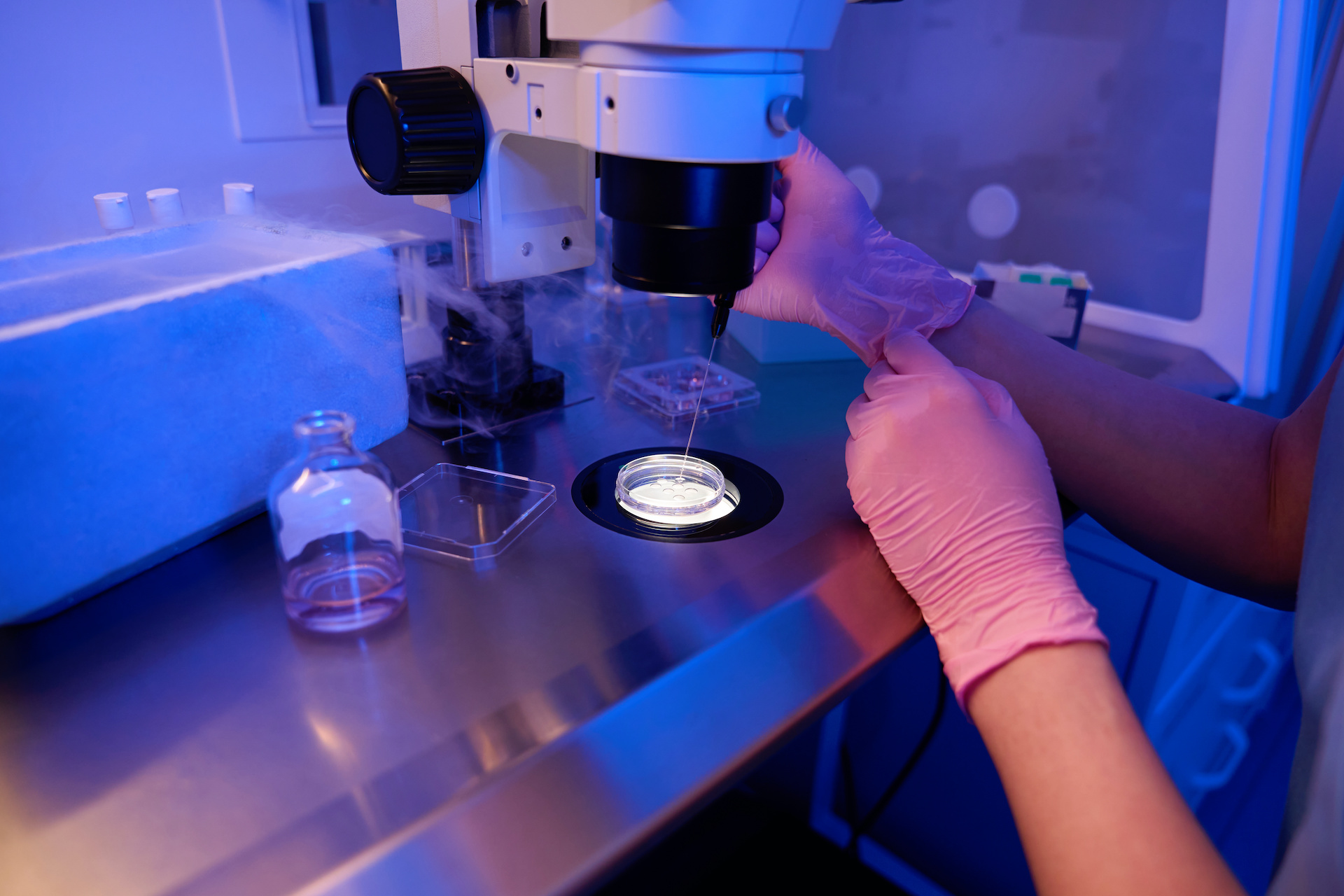 Nov 03, 2024 | by Lucy Solie-Vilker, Program Director
Nov 03, 2024 | by Lucy Solie-Vilker, Program Director
There are quite a few reasons why frozen donor eggs are an appealing option for many intended parents, mainly because the entire process is more straightforward, and therefore quicker, than a fresh egg donor cycle. However, hopeful parents used to have to balance the convenience of frozen donor eggs with the fact that they typically had lower success rates than fresh. Fortunately, thanks to many amazing advancements in the field, this may no longer be the case.
Recent studies are demonstrating that frozen donor egg success rates are catching up to fresh and, in many cases, do not show a significant decrease in outcomes at all.
Success Rates of Fresh vs. Frozen Donor Eggs
So, will fresh or frozen donor eggs give you the highest chance of a successful pregnancy? Of course, that’s the question that’s top of mind when deciding between fresh and frozen donor eggs. Below, we dive into two recent studies that compare the outcomes of fresh vs. frozen donor eggs to give you a clear look at what the data is telling us.
Study 1: Morphokinetic Analysis of Embryos Derived from Fresh vs. Frozen Donor Cycles
By the Embryolab Fertility Clinic in Thessaloniki, Greece, May 2024
This study utilized advanced time-lapse imaging to analyze the development of embryos derived from fresh and frozen donor eggs, providing valuable insights into how these two methods compare. The study included 421 vitrified (frozen) eggs from 58 donation cycles and 196 fresh eggs from 23 donation cycles.

Key Findings:
- Survival Rates: The mean survival rate of vitrified oocytes was an impressive 92.58%, demonstrating the effectiveness of modern freezing techniques.
- Fertilization Rates: While fertilization rates were slightly higher in the fresh oocyte group (80.65%) compared to the vitrified group (71.92%), the difference did not significantly impact subsequent developmental stages.
- Development and Pregnancy Outcomes: The study found no significant differences in degeneration, cleavage, blastocyst formation, pregnancy, clinical pregnancy, ongoing pregnancy, implantation, and live birth rates between embryos derived from fresh and vitrified oocytes.
Study 2: Comparing Outcomes of Fresh vs. Frozen Eggs from the Same Donor Cycle
October 2022
This study compared the pregnancy outcomes of fresh and frozen eggs obtained from the same donor cycle, referred to as "sibling oocytes."
Overall, 7,515 mature donor eggs from 304 donation cycles were included in the study. Each donor cycle provided at least 12 fresh eggs for one recipient and another 12 eggs that were frozen for use by another recipient with a total of 609 recipients.
Key Findings:
- Fertilization Rates: Fresh and cryopreserved-thawed oocytes showed no significant difference in fertilization rates (9.1 ± 1.6 vs. 9.7 ± 2.0).
- Blastocyst Ratios: Both groups had similar blastocyst ratios (58.9 ± 21.7% for fresh vs. 51.3 ± 21.2% for cryopreserved-thawed).
- Clinical Pregnancy Rates (CPR): The CPR was similar for both fresh (66.8%) and cryopreserved-thawed (60.7%) oocytes.
- Live Birth Rates (LBR): LBR was comparable between fresh (59.5%) and cryopreserved-thawed (55.1%) oocytes.
- Other Factors: No significant differences in miscarriage and multiple gestation rates between the two groups.
The study concluded that there was no significant difference in terms of reproductive outcomes between sibling fresh donor egg cycles and frozen donor egg cycles.
Modern Techniques Continue to Boost Success with Frozen Donor Eggs
Thanks to the many advancements in cryopreservation techniques over the past two decades, the outcomes of using frozen donor eggs have greatly increased. This is largely due to the development and implementation of the vitrification process which was introduced around 2006 and is now the gold standard worldwide. Vitrification involves rapidly cooling the eggs to prevent ice crystal formation, which can damage the cell structure. This method has led to higher survival rates and better overall outcomes.
We Live in an Exciting Time With Many Innovations on the Horizon
Within the past decade, we’ve seen the introduction of many new technological innovations, such as time-lapse imaging, which allows continuous monitoring of embryo development. With the ongoing refining of current techniques and many new innovations on the horizon, embryologists and researchers continue to collect valuable insights to optimize the process and increase success rates for hopeful parents.
Frozen Donor Eggs: A Promising Path to Parenthood
With comparable success rates to fresh donor eggs and the added bonus of convenience and flexibility, it’s no wonder why frozen donor eggs are becoming an increasingly popular option among physicians and patients alike!

About the Donor Nexus Egg Bank
The Donor Nexus Egg Bank is located in Newport Beach, California, and ships frozen eggs to fertility clinics worldwide. With both nonidentified and open ID donation options, a personalized touch, and a Blastocyst Embryo Guarantee, we offer a proven, flexible approach to egg donation. As a boutique egg bank, we attract premier egg donors from around the world and share their comprehensive profiles in our online database for interested recipients to review. Over the past twelve years, we have supported over 1,200 parents on their unique journeys and we look forward to assisting you in any way we can!
Find Additional Resources and Inspiration on Our Blog:
- Fresh vs. Frozen Donor Eggs: Deciding Which Route to Take
- Victoria’s Journey to Baby #2 Via Frozen Donor Egg
- Epigenetics: Donor Egg Recipient Mother’s Influence Starts in the Womb
- IVF Grants: Our Comprehensive 2024 Guide
- Bonding and Attachment: My Experience as a DEIVF Mother
- Explaining Donor Conception to Your Child: Do’s and Don’ts
References:
- Karagianni, M., Papadopoulou, M. I., Oraiopoulou, C., Christoforidis, N., Papatheodorou, A., & Chatziparasidou, A. (2024). Embryos from vitrified vs. Fresh oocytes in an oocyte donation program: A comparative morphokinetic analysis. F&S Science, 5(2), 174-181. https://sciencedirect.com/science/article/abs/pii/S2666335X2400017X
- Gursu, T., Goksever Celik, H., Eraslan, A., Angun, B., Ozaltin, S., Yeh, J., & Bastu, E. (2022). Comparison of pregnancy outcomes of 7515 same donor oocyte cycle fresh and cryopreserved-thawed oocytes in 609 donor oocyte recipient cycles: A single institution analysis. European Journal of Obstetrics & Gynecology and Reproductive Biology, 277, 110-115. https://sciencedirect.com/science/article/abs/pii/S0301211522004808
The information provided in this blog is not to be considered medical advice. Please consult with your physician for actual medical advice specific to you.
Donor Database
Register now to receive free and instant access to our online donor database.
GET STARTED →My dreams have come true!
“We are enjoying our baby and we just love him so much!! Thank you again for this amazing gift- I’m so forever grateful. My pregnancy was so wonderful and I am really looking forward to everything… It’s amazing what you do for people. My dreams have come true!”
– Intended Parent B.M.



